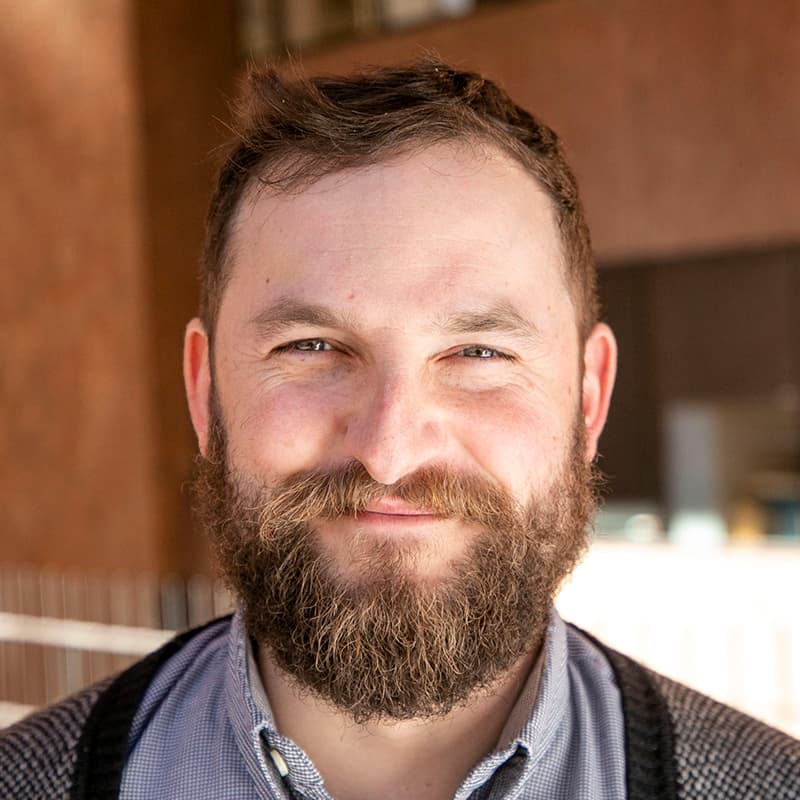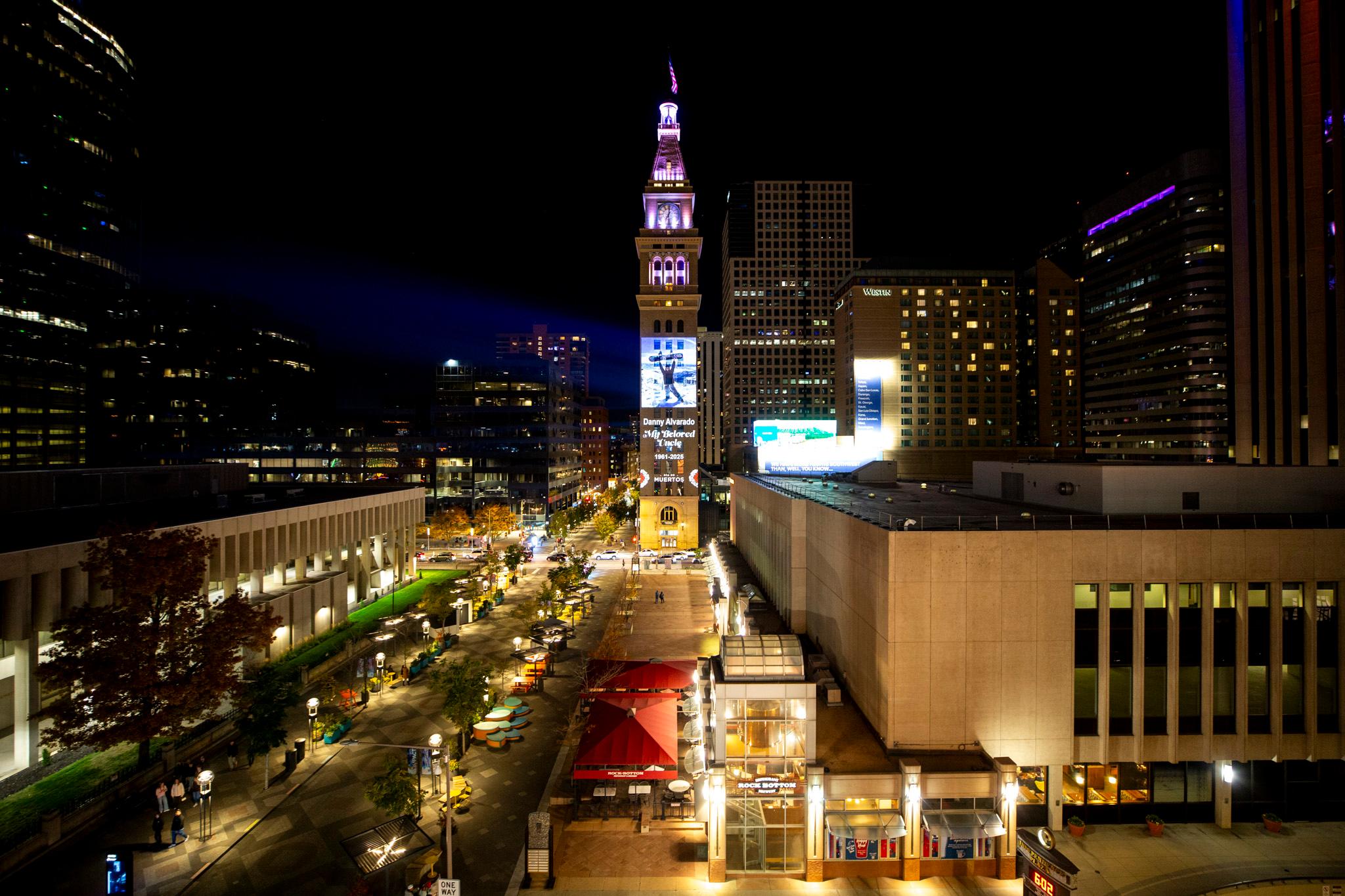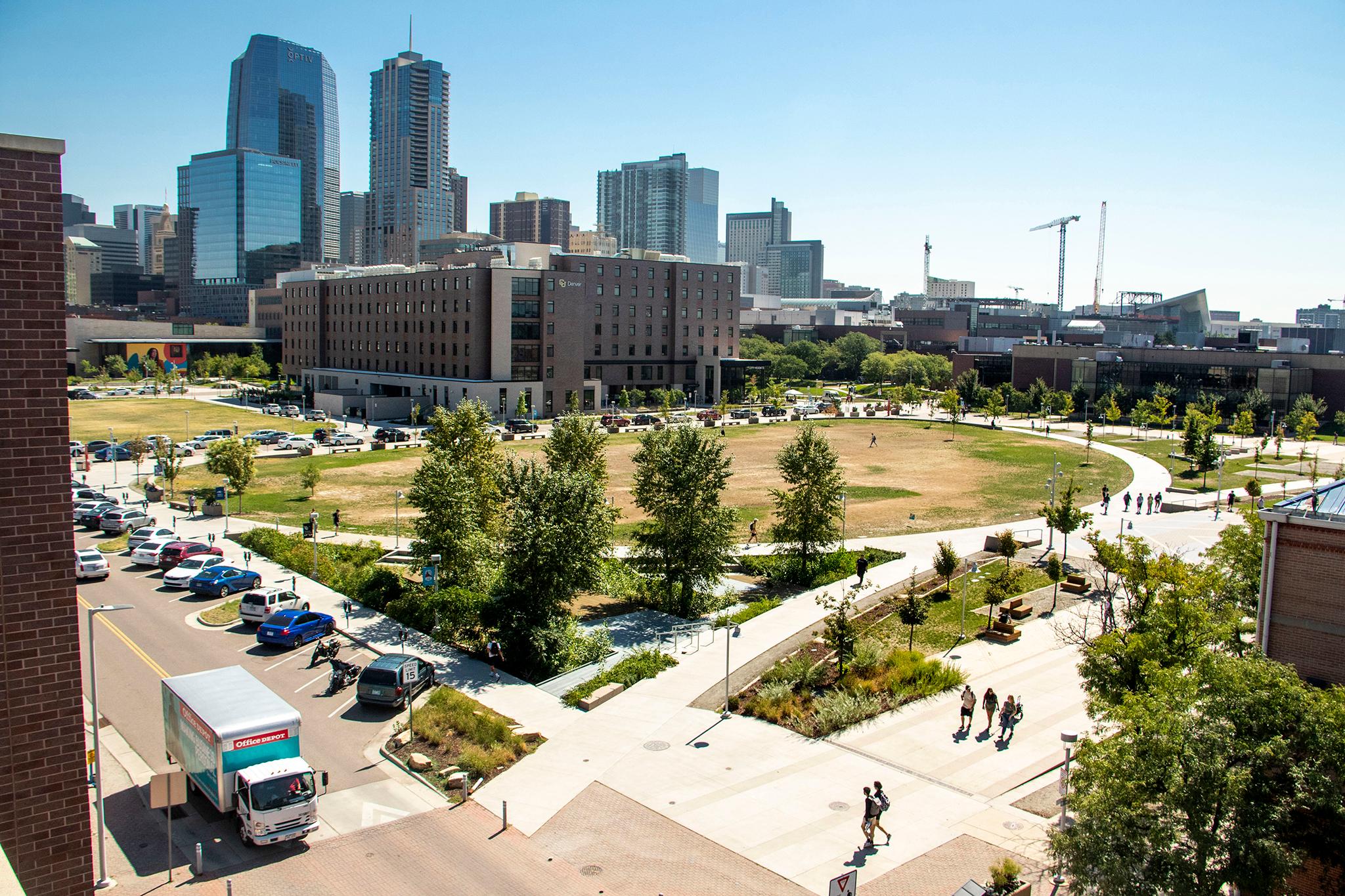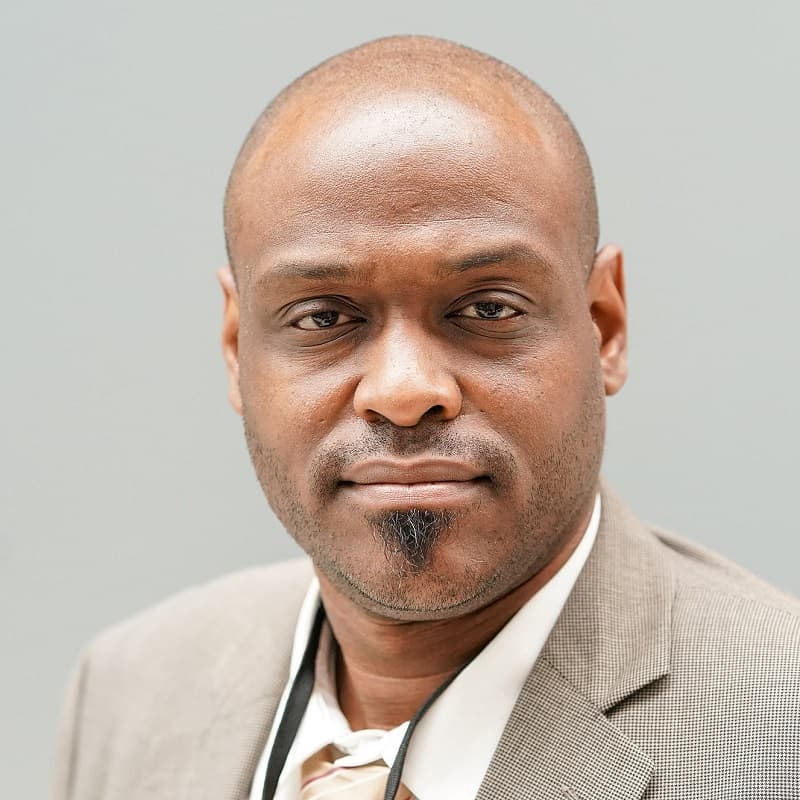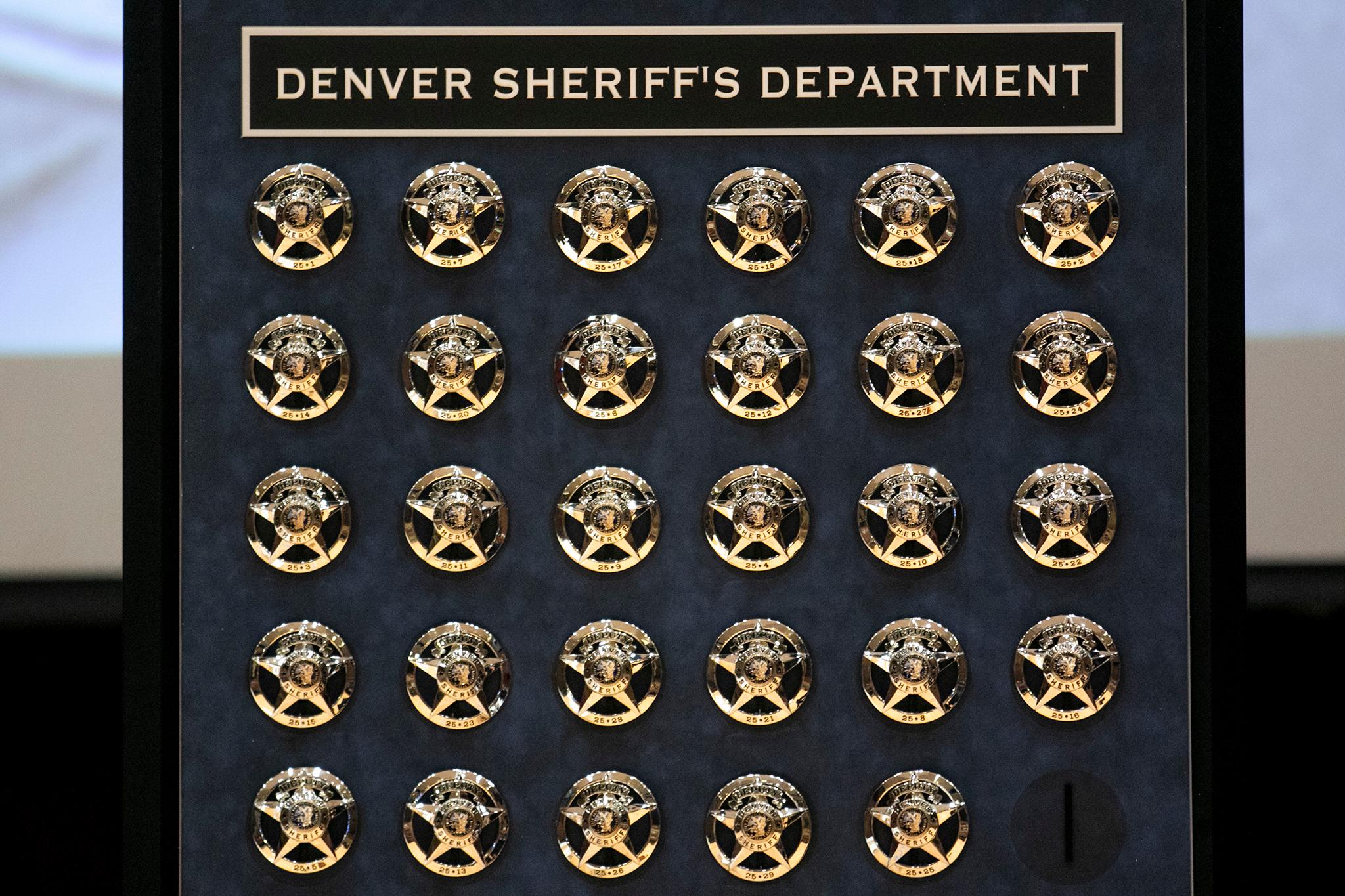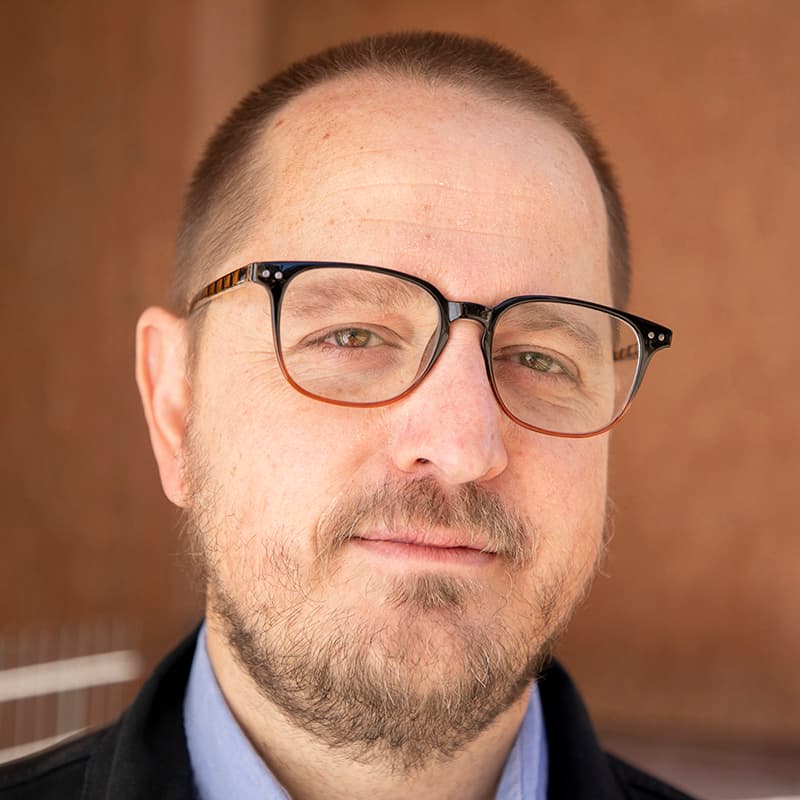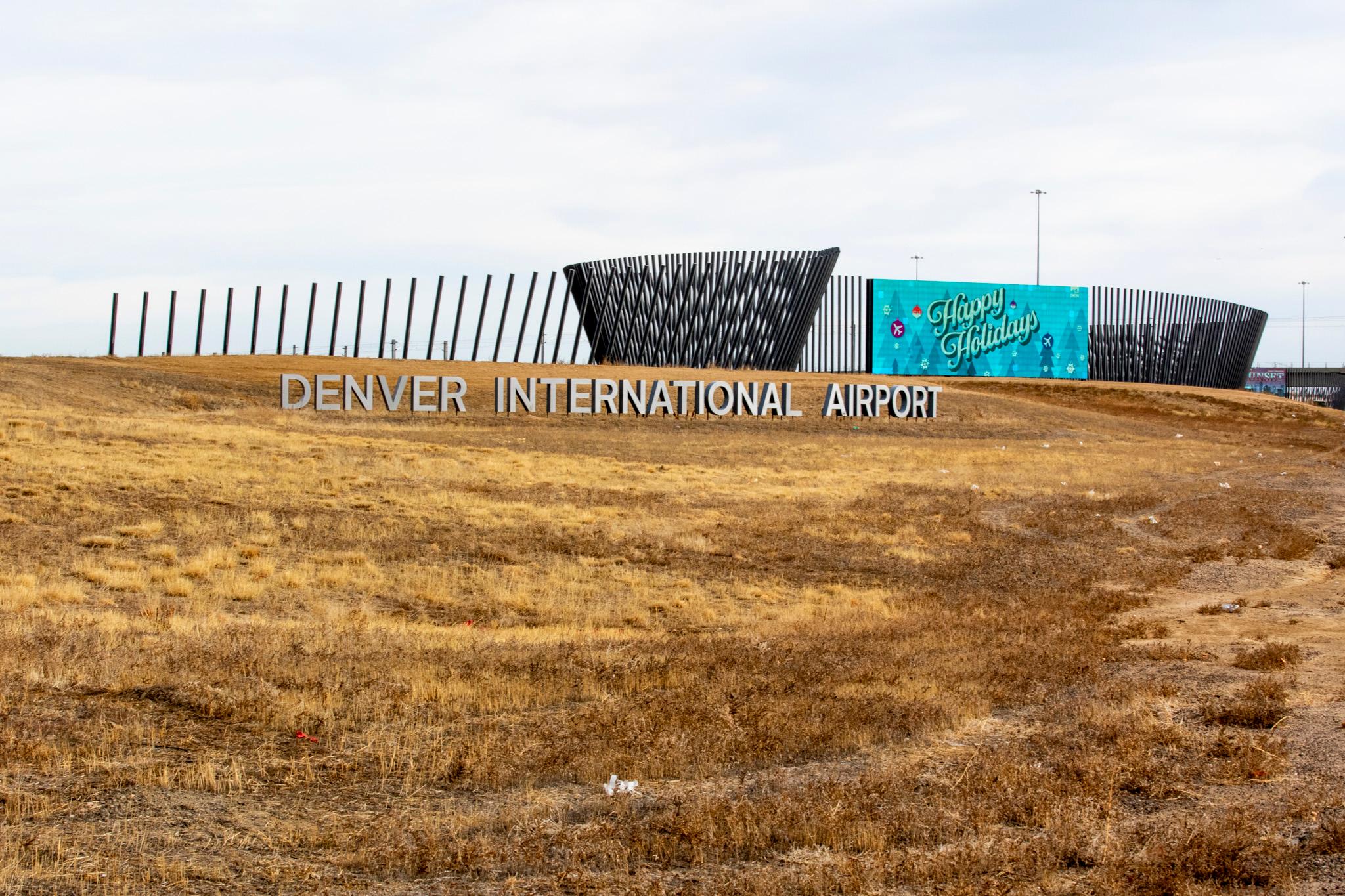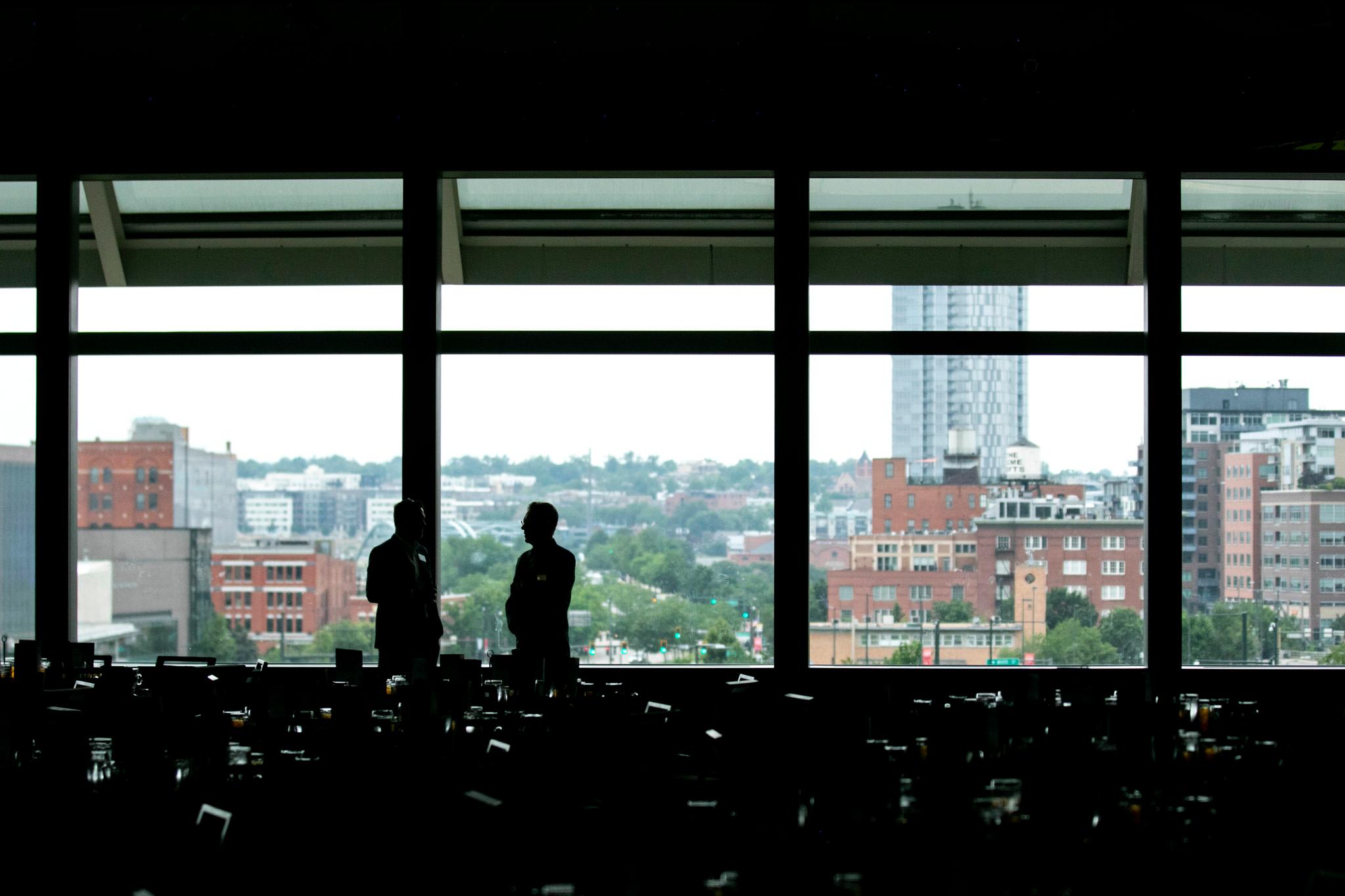There was magic in the air over 16th Street on the first day of this month. It was more than the shortening days, the new chill in the air, or, on this night, the endless stream of crows sailing into downtown to roost.
A small crowd gathered on the patios near Arapahoe Street to gaze at the city’s iconic clock tower. They leaned on each other, comforted one another, as portraits of their loved ones filled the building’s 21-story rise.
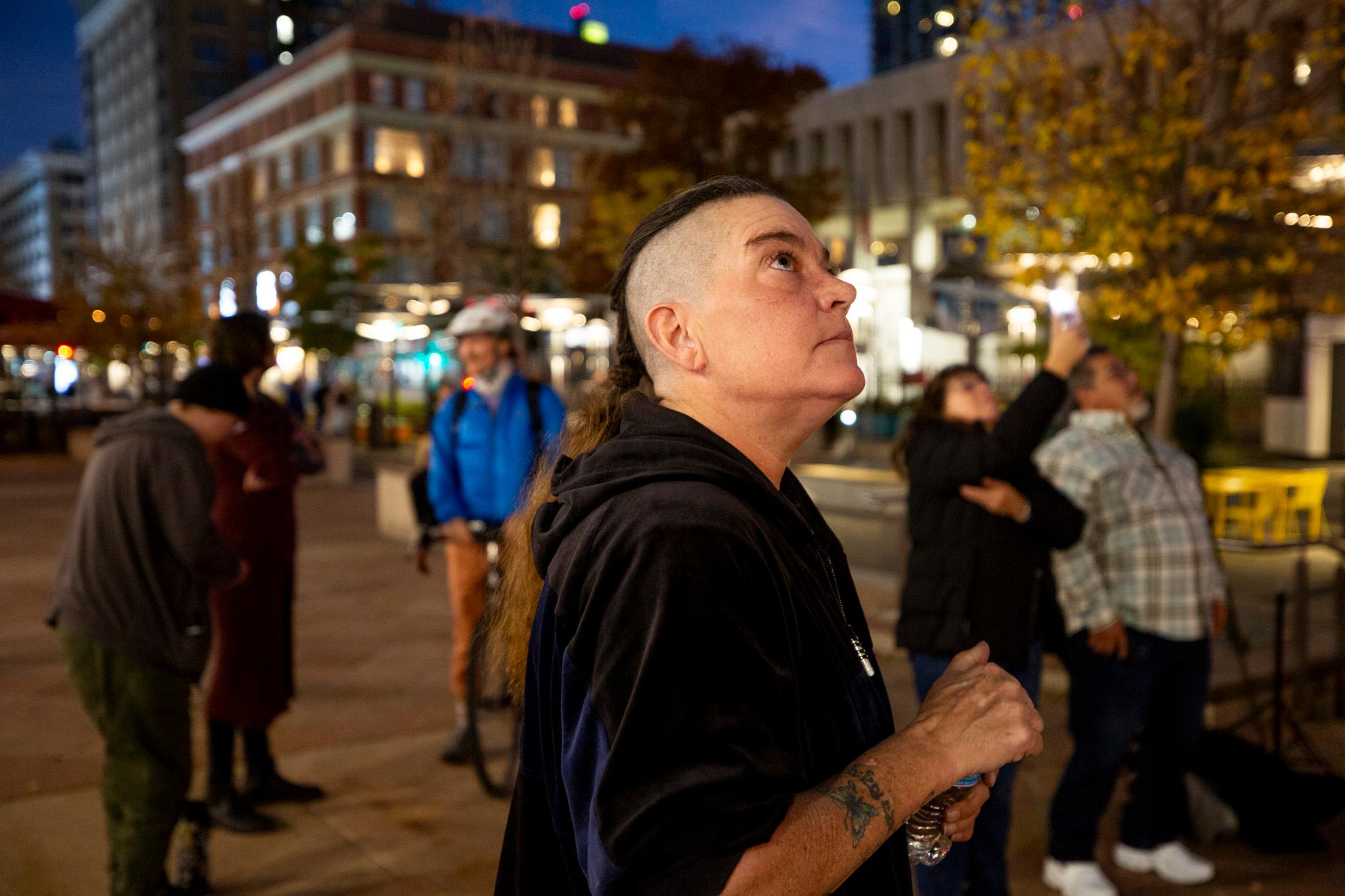
This was the fifth year that Night Lights Denver, which operates year-round projections on the building, has partnered with the Art District on Santa Fe for the district’s annual observation of Día de los Muertos — the Day of the Dead.
More than 100 people had nominated loved ones for the giant ofrenda, which lit up downtown on Saturday night for the holiday.
The image collection will be projected again this Friday on the side of Su Teatro during the Art District’s monthly First Friday Art Walk, alongside an annual procession through the neighborhood at 6 p.m.
Denverite joined the memorial project this year to learn more about the people honored on the tower — and those who nominated them. What follows is the result of 12 interviews with people who agreed to share more about the ones they loved.

They had all lost someone recently, and they were wrestling with how to carry on.
They spoke about family and friends, young and old, and the things they loved and missed.
Scott Rittinger remembered his mother, Bette, as an “amazing force of nature” who built her dream life in the open air in Breckenridge and, later, Nederland. Samantha Reifer told us about her father — Richard, or Rick, or BD — who delighted in the girl-dad task of carting his daughters to dance and volleyball and soccer, wherever their hearts desired.
Their absences would be felt for another lifetime.
“It will be hard to sit there on her couch and watch a movie on her big TV and have her not be there in the flesh,” Ellis Koop said of their “best movie buddy” Laura Givens. “I don't want to let that part of my life go altogether.”
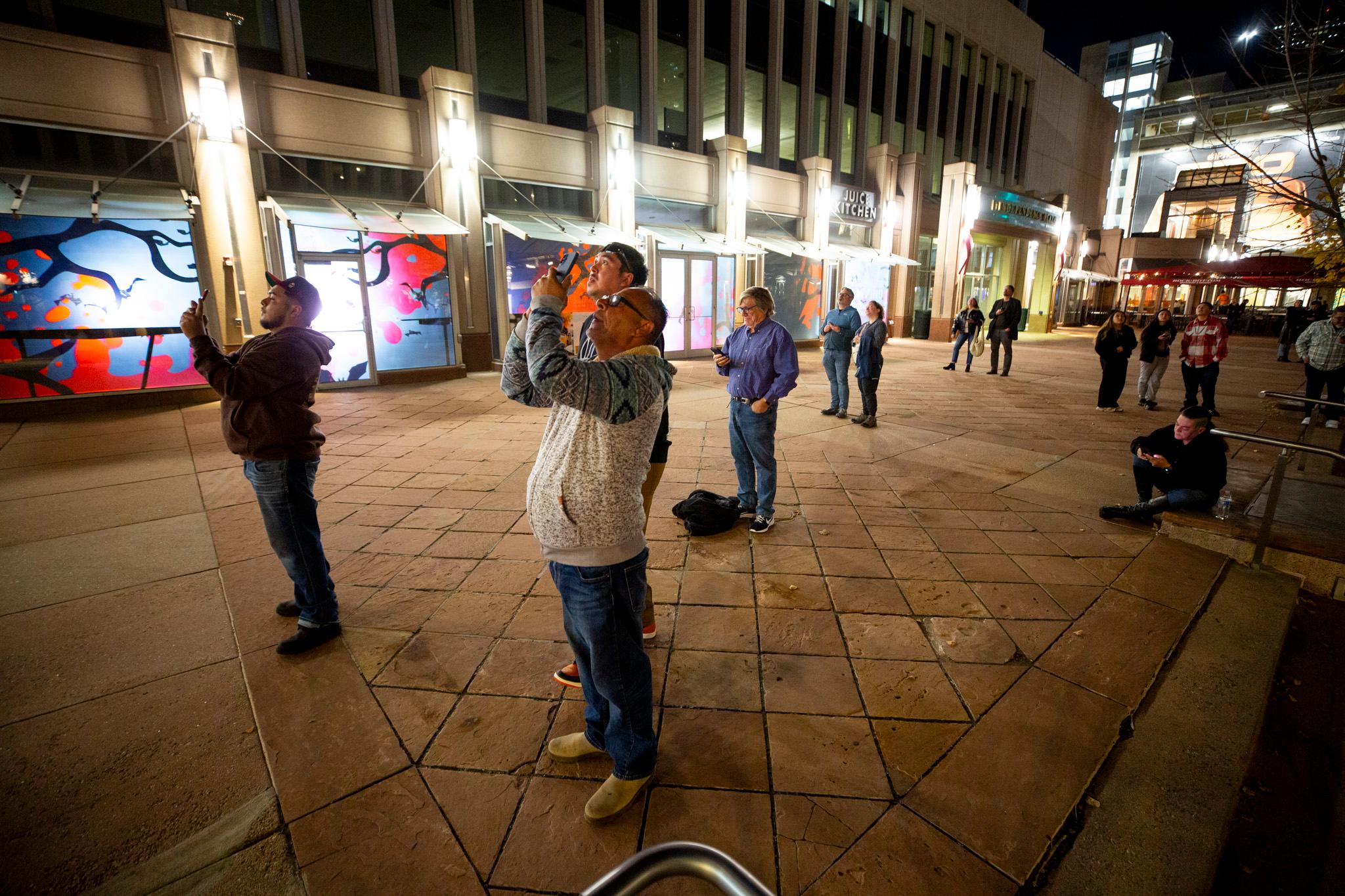
Robert Ramirez told us about his grandmother, Gregoria, or Goya, the “matriarch” who held his family together. He worried his bonds with his cousins and his tias might fizzle without her. It was a fear we heard from a lot of people.
“I felt like I lost my most important connection to home,” Geoff Taylor said after his mother, Melinda, passed away last May.
“If you lose somebody, especially somebody close to you, you spend a lot of your time kind of erasing her, erasing that person. They go off your joint account, they go off insurance, they go off the will, and the fact of her disappearing, it's hard,” Peter Locke said, as he spoke about his late wife, his “soulmate,” Diana. “So the fact that there's another way to celebrate her and remember her, in this case in a big way, is pretty neat.”
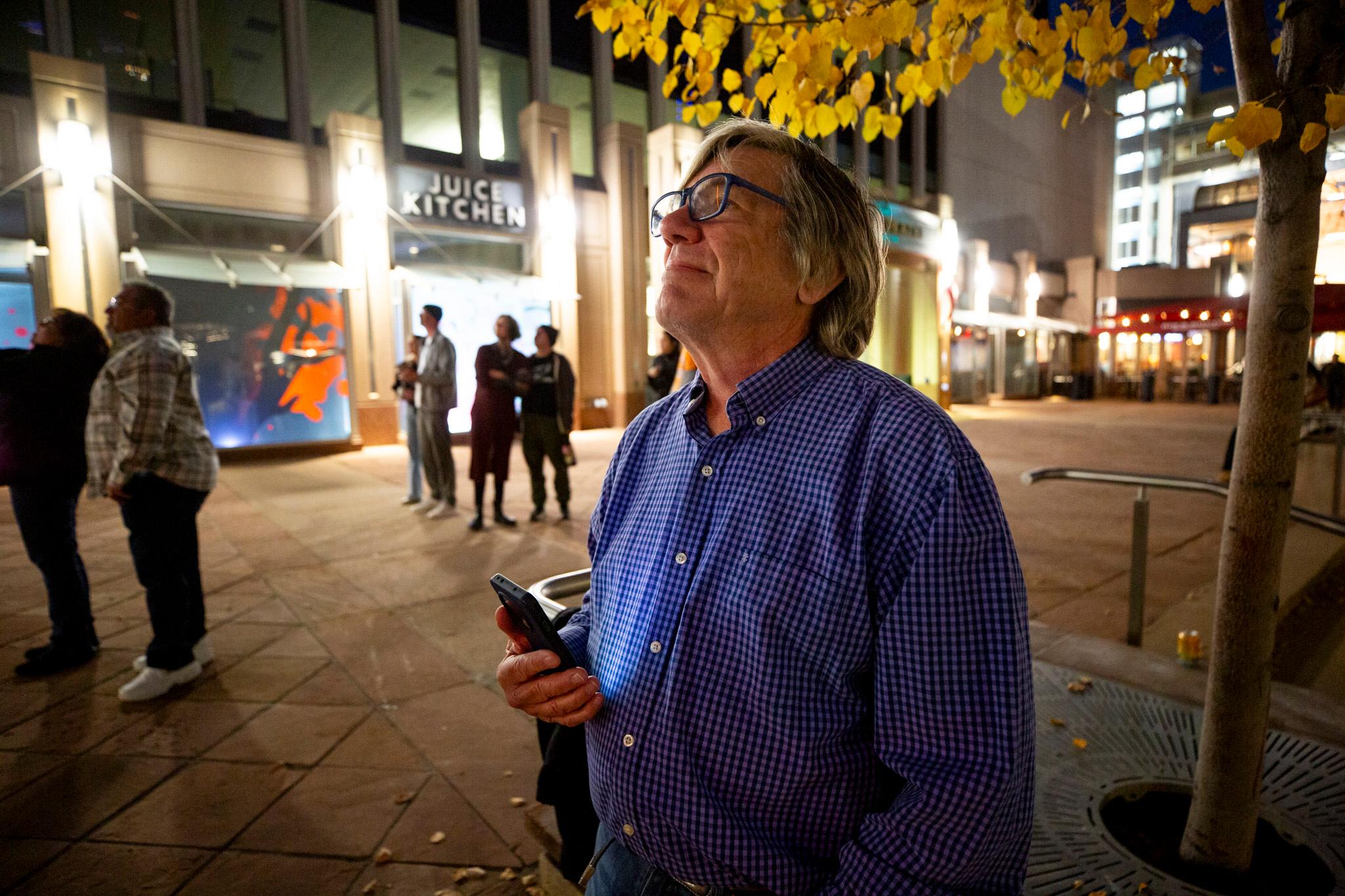
Peter Locke watches for a portrait of his late wife, Diana Locke (1961-2025), to illuminate downtown's Daniels and Fisher clocktower for Dia de los Muertos, Nov. 1, 2025. Kevin J. Beaty/Denverite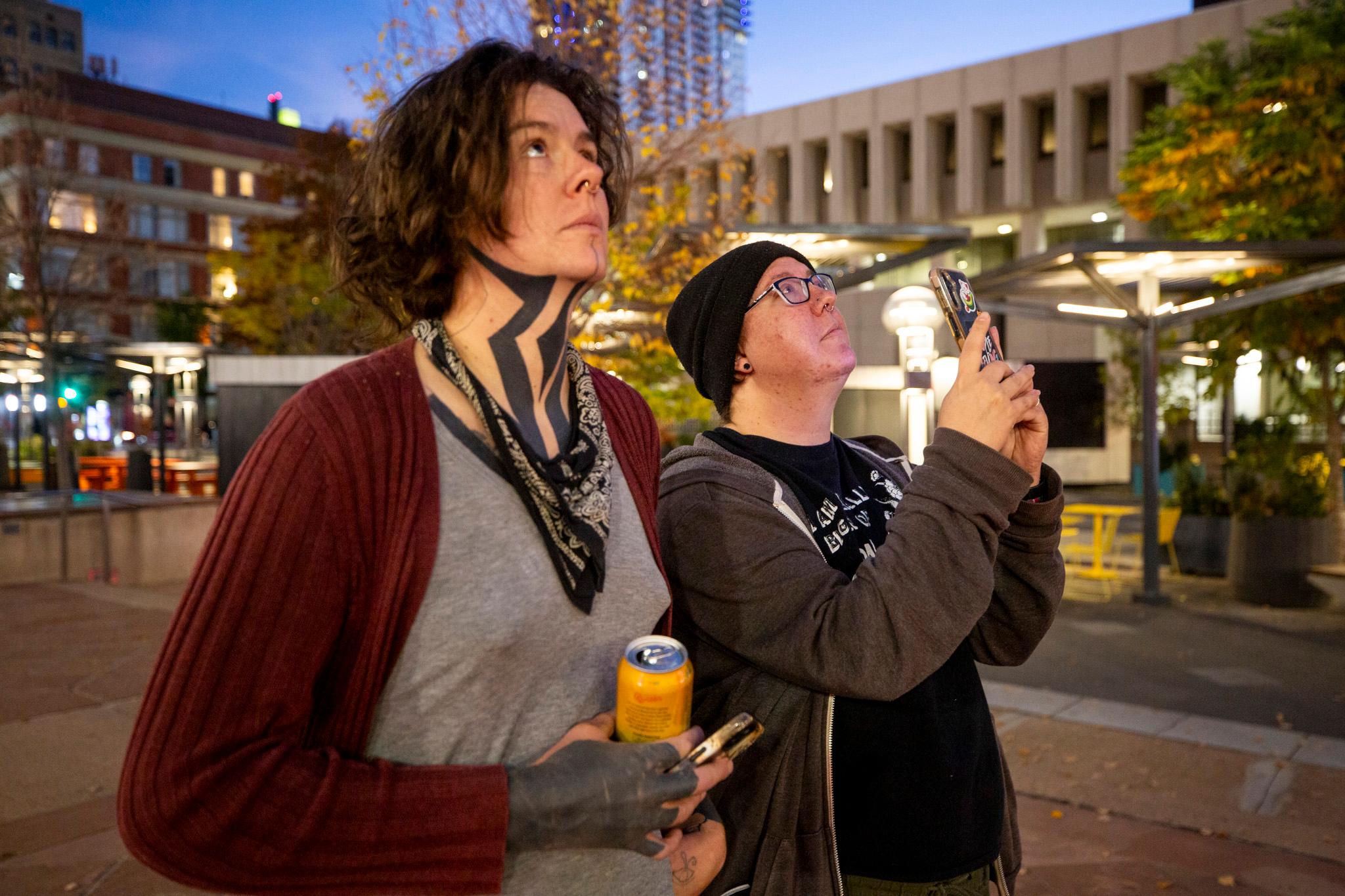
Ellis Koop (right) and Rhosyn Stetler watch for a portrait of Laura Givens (1953-2025) to light up downtown's Daniels and Fisher clocktower for Dia de los Muertos, Nov. 1, 2025. Kevin J. Beaty/Denverite
People found solace, and grief, in small daily reminders: the photograph on the wall, the favorite song. This act of intentional remembering, especially on a scale so large, was also bittersweet.
Some people, like Loren Hansen, grew up with Day of the Dead. He knew he would use the observance to honor his grandmother, Betty, whom he called weekly and who supported him from afar when he moved to Georgia and then Colorado, leaving his family behind in California.
Many others found their way to the holiday for the first time, looking for a way to ensure those they lost would not fade from their hearts.
“We'll never forget him,” Chasity Torrez said of her late son, Sam, whom she raised and protected as a young, single mother. Día de los Muertos is now a tradition her family will recognize every year.
“We'll always carry it forward. And every day we remember him and we think of him and we miss him and we love him,” she said.
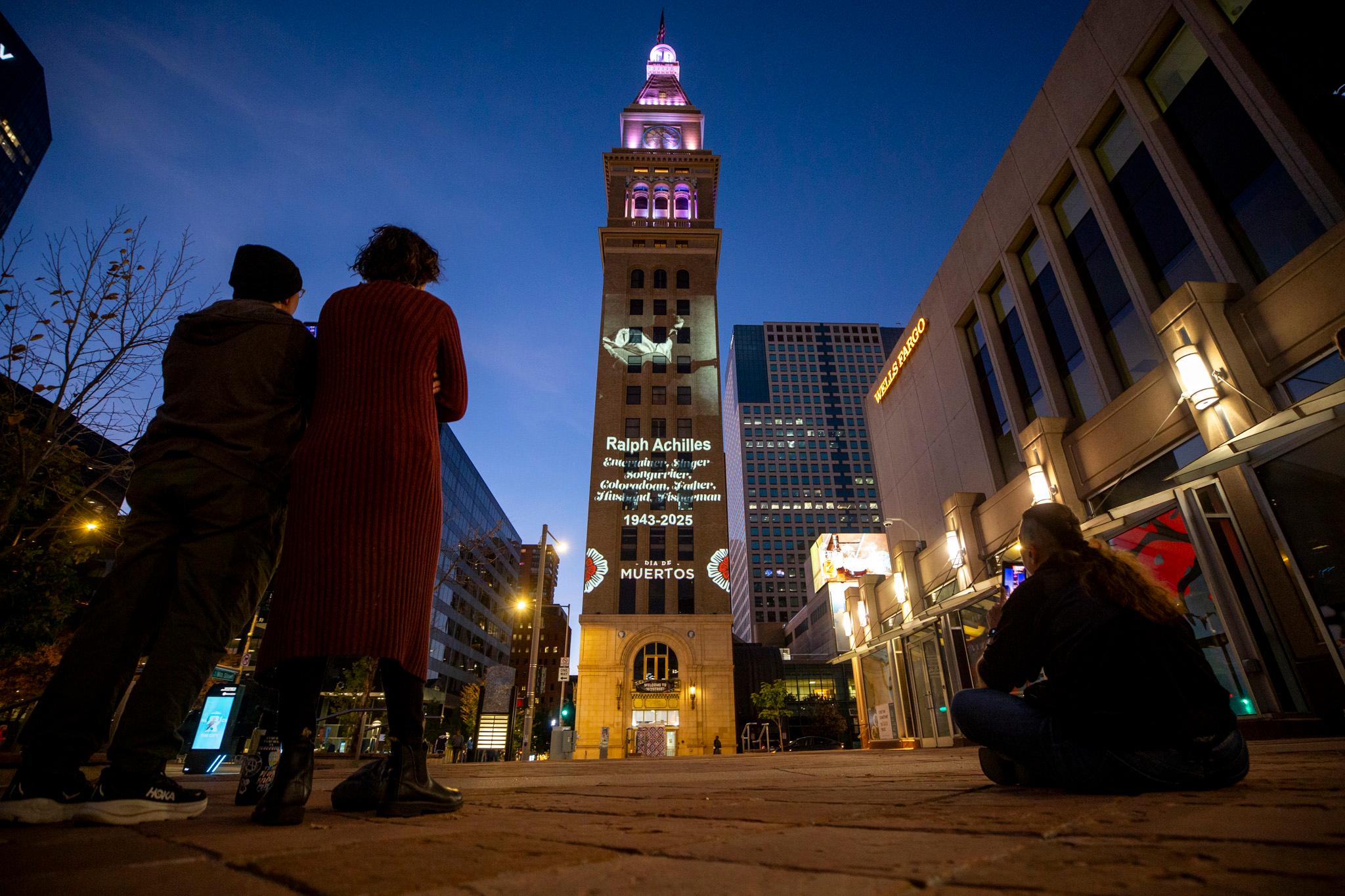
Here are the stories people wanted to save:
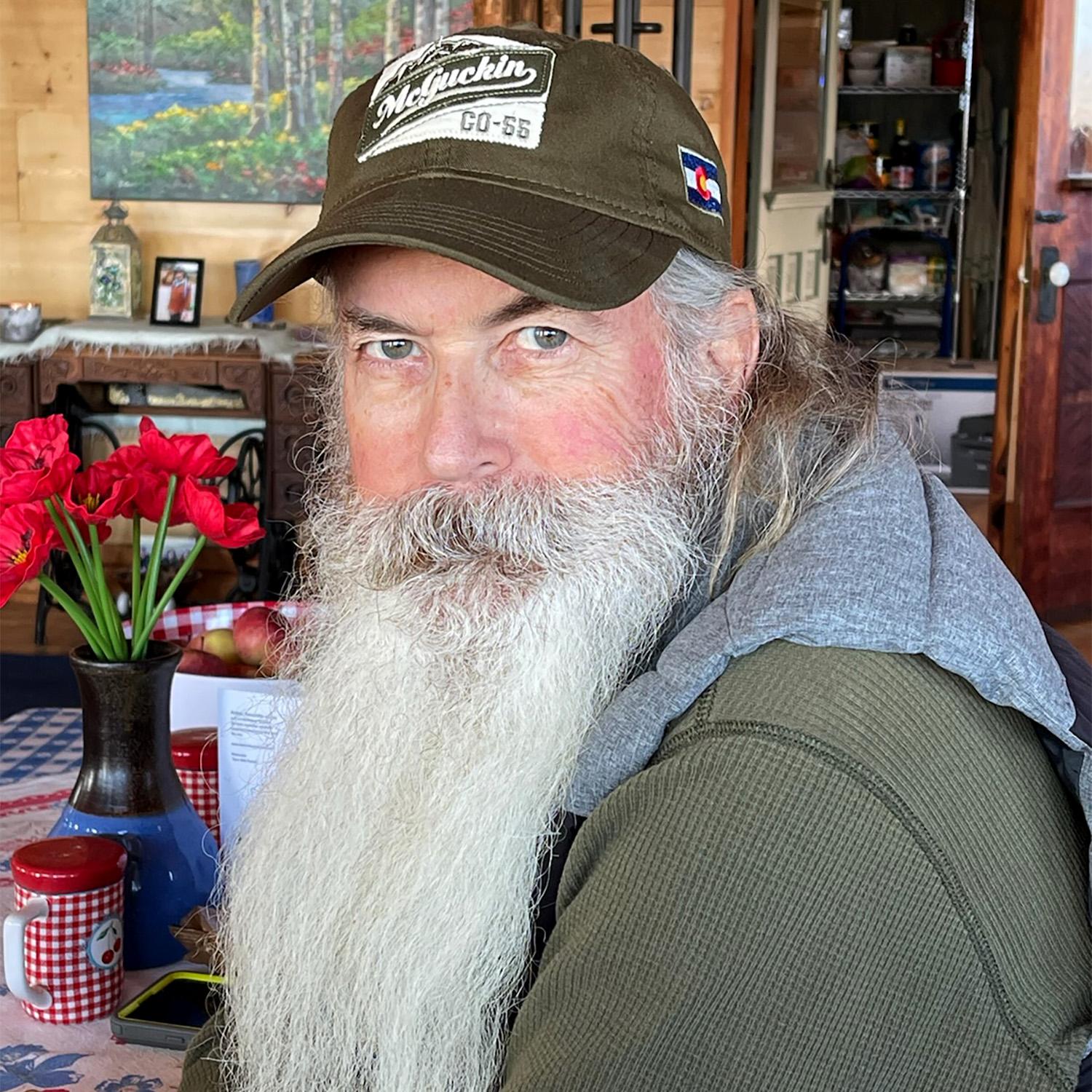
Travis Horton was Marijoy Phillips’ father-in-law. Horton became like a father to her as she fell in love with his son.
“He just was able to love me in a way that my parents didn't,” she said. “It was kind of being seen, and loved, and having fun, and listened to. Nothing was threatening to him. It was just unconditional love and very generous.”
“Everybody who met Travis was drawn to him. He's just genuine and kind of has a sparkle and just saw people really well. He grew up in a small town in West Texas and did a bunch of stuff, graduated from A&M, did a bunch of travel. Just in 2018, finally followed through on a dream of his to live in Colorado,” Phillips said. “Built a house from scratch in the San Luis Valley.”
“He was always doing something. Always making something. Creating something. And then, in the past several years, he wrote a bunch. He reflected and wrote a lot of poetry. It was really beautiful and profound,” she said. “I just felt like he would live forever.”
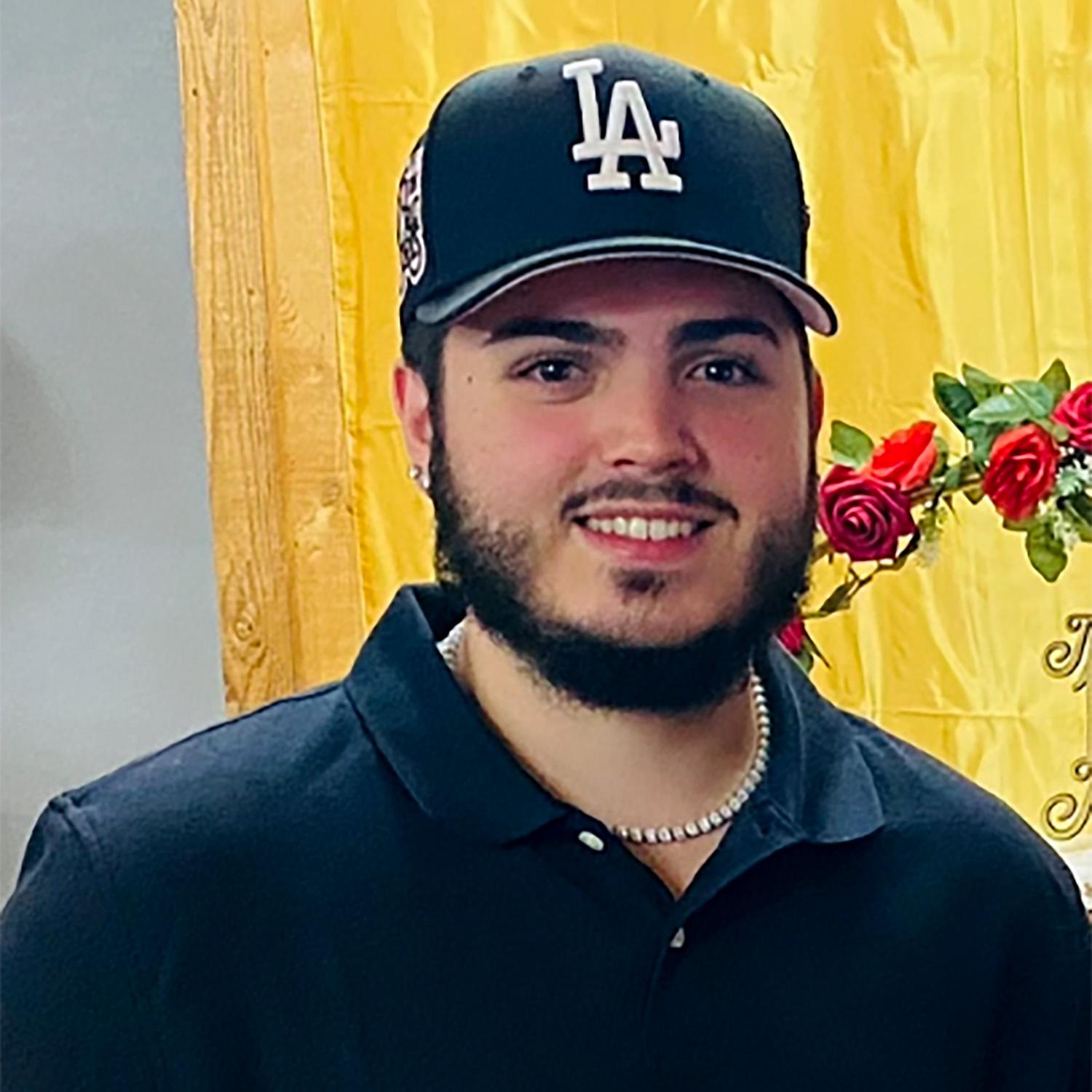
Sam Samaniego was Chasity Torrez’s son, who died in April at the age of 21.
“He was my first love. The child that made me a mother at a young age. I was only 18 when I had him, and I would tell him we grew up together — and we did a lot. We explored and we learned a lot together. And he became and was becoming such a great man. He was humble and kind and giving, generous,” she said. “He loved being funny, cracking jokes. He loved food — man, that kid, he loved food.”
“I'd always tell Sam that he saved me from going down the wrong path, because he always brought me back to center, home. I had to care for him,” she said.
“He was there for me and for dinner. And, ‘Mom, did you need me to check your oil?’ And, ‘Mom, did you put in gas?’ And he was very protective of me. And also my mother, his grandmother,” Torrez said. “Oh Nana, let me carry the groceries in for you. Oh Nana, let me mow the grass for you. Nana, let me help you clean the leaves. Let me wash the car.”
“People think as time moves on, ‘OK, you’ve got to let it go and you’ve got to get back into normalcy.’ But there is no new normalcy. It's new now. It's different and it's scary. And for me as a mom, it's really hard to want to move forward because I don't want to move into the future because he's not there physically.”
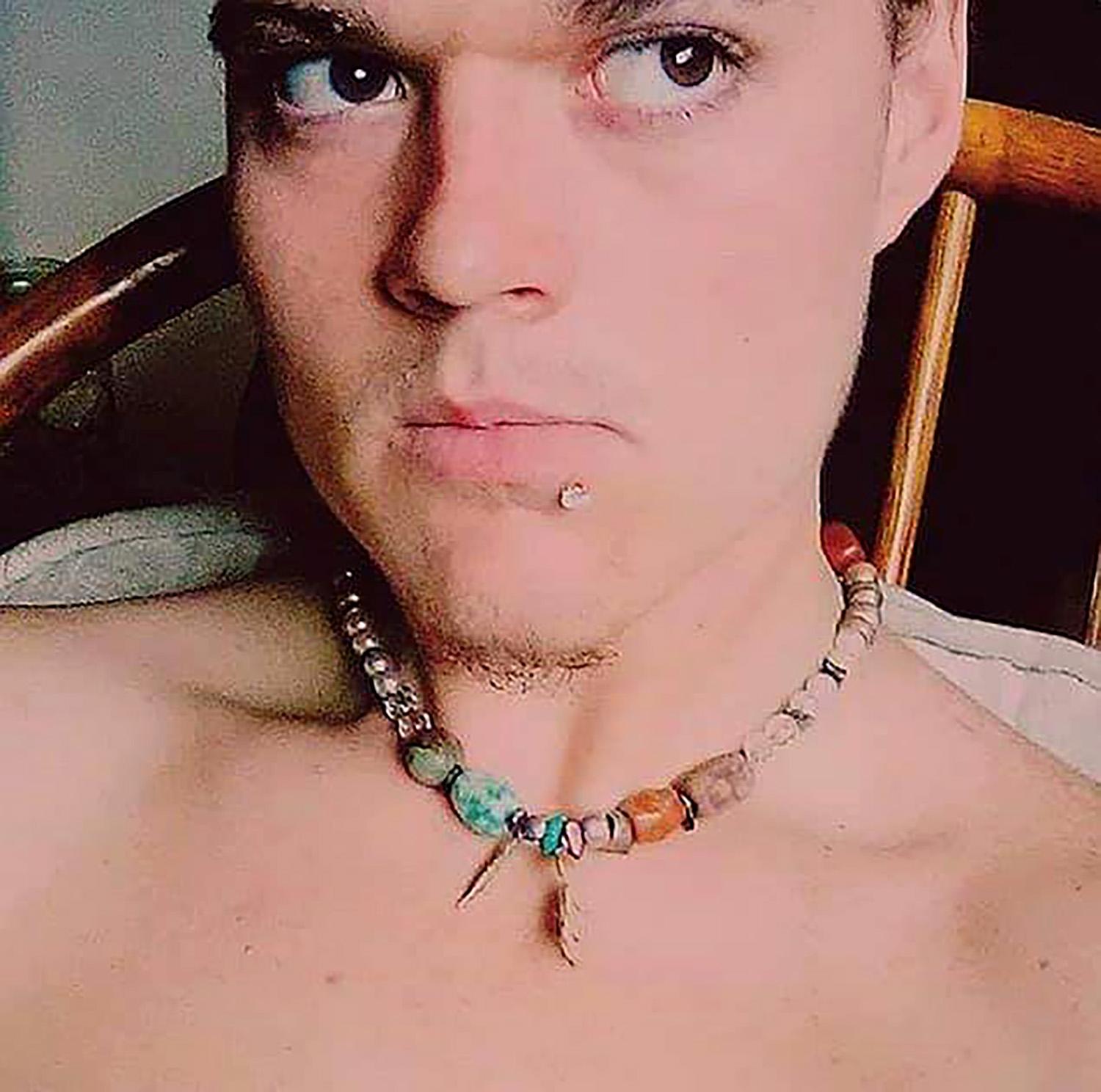
David Jaxon Page, 1999-2019 and finally laid to rest in 2023. Courtesy: Crystina Page
Kathy David, 1956-2025. Courtesy: Crystina Page
David Jaxon Page and Kathy David were Crystina Page’s son and mother. She shares the fear of forgetting that Torrez described, and she has made it her mission to remember her loved ones.
David was killed by El Paso County Sheriff’s deputies in 2019, a controversy in itself that spiraled after Page discovered his body was also mistreated by the Colorado Springs-based Return to Nature funeral home. Litigation in that case is ongoing. She said her mother, meanwhile, was being mistreated in an assisted living facility before she died.
Page said grief has been replaced with determination for justice. She started a nonprofit to advocate for victims and their families, like her. But she, like others we met, was glad the community ofrenda offered a different kind of outlet, too.
“This was a really good opportunity to share him with the world, not as someone who's advocating and fighting, but just as someone who loves him and misses him and is celebrating his life and grieving his loss. And I also don't want the world to forget my mom,” Page said.
“She was the most selfless person I have ever met. She gave everything she had to the people that she loved. I've read through some of her journal writings. Some of it's painful to read, but I also read some of the words that she spoke about her children, her grandchildren. I realized how much she really loved the people that she put love into.”
She added: “David had a smile that would just light up the room, and his sense of humor was just ridiculous. He loved to sing and he loved to write.”
She and her son dreamt of founding a wildlife preserve together in the San Luis Valley.
“It really speaks to who David was as a person. He really wanted the world to be safe,” she said. “If people just had a safe place, then they wouldn't have to be hurt, or sad, or angry.”
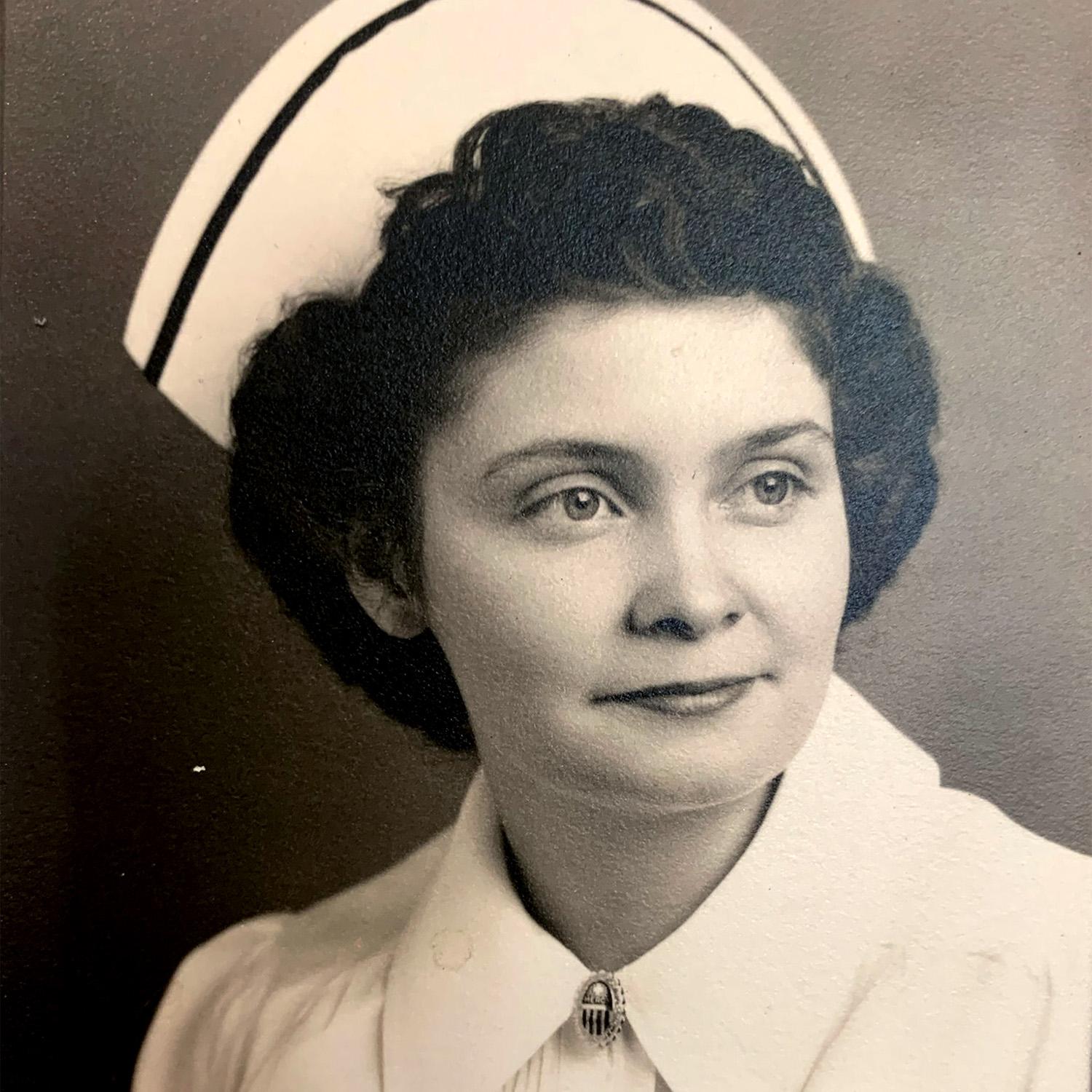
Betty Hansen was Loren Hansen’s grandmother, the person who always called to check on him wherever he went.
“That photo of my grandmother in the nursing outfit traces its way back to World War II,” he said. “My grandmother was part of the greatest generation. My grandfather, also named Loren, was a military vet and came back and married my grandmother who was a nurse. So you think of that famous photo in New York.”
She took care of people her whole life, he said, as a nurse and in her private life.
“She was one of the people that used that strength and kind of that caregiving to check in on me when I was at the beginnings of my stages of establishing myself in Denver,” he said. “She called me constantly, pretty much weekly.”
“My grandmother was always someone that loved cooking,” he said. “Two generations later, I learned a lot of the recipes that she had … I'm really happy she passed that along to me.”
“We did have a special relationship.”
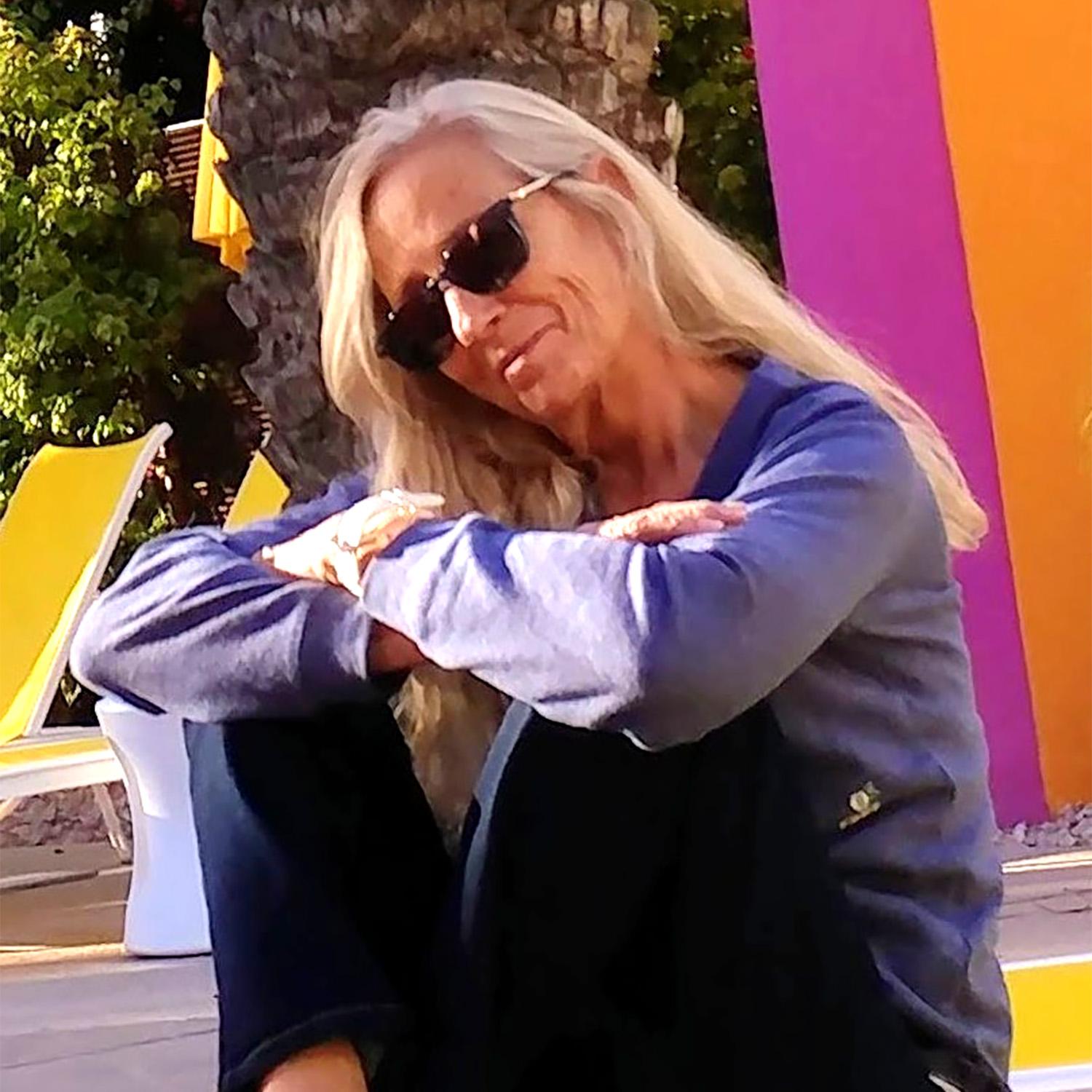
Diana Locke was Peter Locke’s partner for 31 years of life and spouse of 27 years.
“She was the one person I could talk to about everything and anything. She was always in my corner. I always knew I had that one person there who would support me, back me up,” he said. “She raised good kids. She was a generous, creative person who did things for people that I think they still are thankful for today. And she added to the ripple effect of doing good things for people. And those people turned around and also did good things for others. She was just a good soul in the world.”
“She was a graphic artist. She would paint, she would do photography, got into jewelry,” he said. “And that smile, as I look back at all our pictures, she always had that great smile.”
“And grief is, I mean — you've probably lost somebody close in your life. It comes and goes. You can't dwell on it too much. You have to keep moving ahead. You have to keep going forward. That's what Di, I think, would want. But there are those moments where it is just kind of overwhelming and it hits you like a big wave. That's what a lot of people say. It's like the waves in the ocean. It just once in a while you get banged by one and it just knocks you over.”

Laura Givens was Ellis Koop’s friend, “queer elder” and “best movie buddy.”
“Both to me and to the world, Laura was just this amazing, silly, openhearted, quick-witted, give-you-the-shirt-off-her-back type of person,” they said. “I came to her when I got divorced and she said, ‘I'm sorry about that, and what can I do for you?’ Just absolutely no judgment about anything you ever told her, and always this readiness to ask you, ‘Okay, well what do you need from me? What can I do to help you?’”
“I was a queer teenager when I met her, and she was someone that I could talk to,” they remembered. “She was a person I could come out to when I came out as trans. I think that’s the difference, in chosen family, is that it's not as easy for people to get the breadth of the loss in a snap-your-fingers type of way.”
“All of Broadway reminds me of her. She lived by my work, and we used to go to Rosemary's all the time. Right after she died, it was really intense, because everything in the city made me really upset. Now it calms down a little bit,” they said. “These things just kind of hit me. A big part of our relationship, since the pandemic, was getting together once a week to watch a movie. And there are so many silly movies that I think of and I'm like, ‘Damn, I wonder if Laura has seen this,’ or ‘We should watch this together.’”
“She was just a riot. I miss her a lot.”
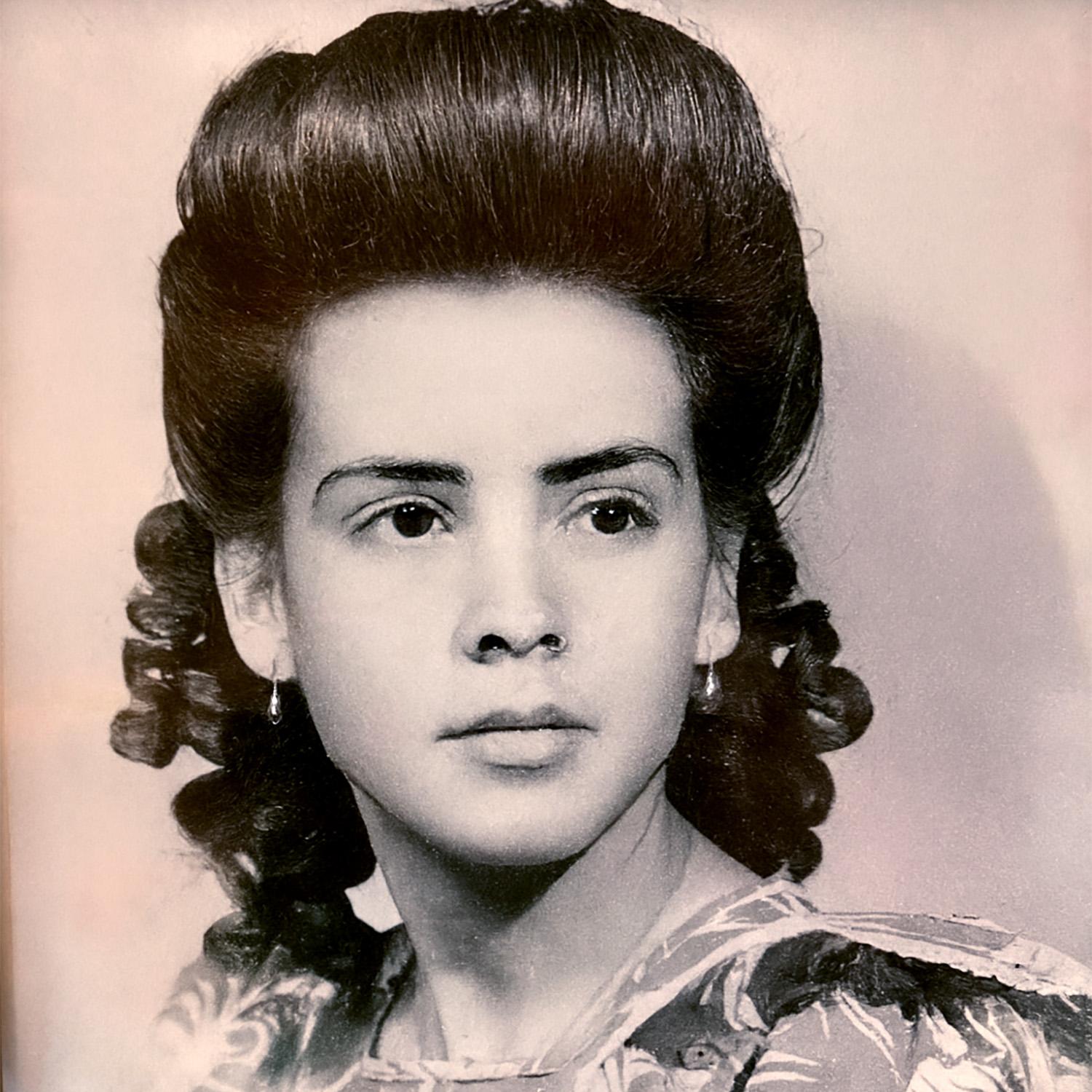
Gregoria Ramirez, or Goya, was Robert Ramirez’s grandmother.
“Her house was the meeting spot. Her house was home for everyone. She always had food going, specifically beans. Anytime there was a gathering, we'd be there at grandma's house. As the family grew and grew and we had children of our own, she always wanted to meet them and know them. And so she would call us. ‘Anytime you come to town, mijo, you come, bring the babies, bring the babies.’ So definitely the matriarch. She kept us all together,” he said.
She and his grandfather met working fields on the borderlands where Texas meets Mexico when they were kids, 75 years ago.
“She was 15 years old when she met with my grandfather and they got married right away,” he said. “She kept a pretty strict household. She was pretty strict on my dad and uncles and aunts. And then they carried that same kind of strictness over. It all kind of started with her having to be this woman at 15 and hold down this household, which was probably the norm back then, but still — it's a lot of growing up. It sets the tone for the rest of us.”
“She was the caretaker, but they lived about 30 minutes away from Juarez, from Juarez, Mexico,” he added. “And that was her thing, like thirties, forties, her fifties, even into her sixties: They had best friends that they would hang out with, and they would go to Juarez on a Friday night. They would drink and dance and enjoy themselves.”
“They liked to party, they enjoyed drinks. And my grandma liked to drink even into her older years. She would sit out there with a Budweiser on the porch. Her famous thing was she would have a fly swatter, just killing flies all day, and her Budweiser and a pack of cigarettes. She was not like a saint. She was no saint. But we all respected her. We never talked back. She was a human, not just the ‘saintly grandmother.’”
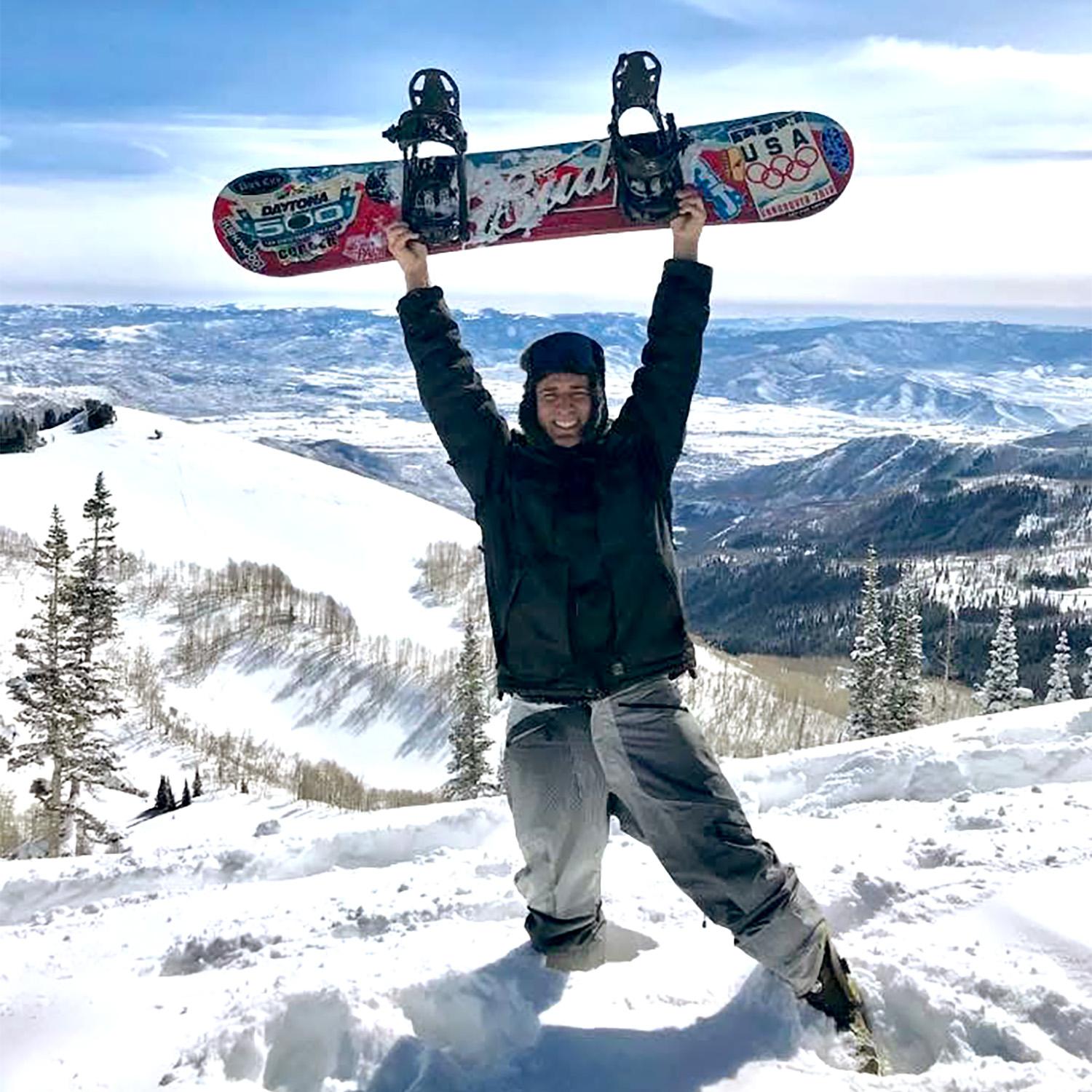
Danny Alvarado was Eric Raya Steinbeiss' beloved uncle.
"I grew up an only child, and he was one of the two male figures in my life," Raya Steinbeiss said. "He grew up in Boyle Heights, east Los Angeles. He was one of eight kids to my grandmother, and he was the oldest boy out of my mom's siblings. And he was the life of the party to so many people."
"He always wanted to own a pool, because he wanted to invite all of his friends over, always, to pool parties. He would fill up a trash can as a kid just so he could dream about having a pool. And so when he was old enough, he bought a house in South El Monte, a suburb of L.A. Then he had a pool, and that's all he ever did. He would host all of my cousin's birthday parties in the summer," he remembered. "And the thing that we always think about with him is he would always just grill up jalapeño poppers, so we had that at his funeral, because he was the consummate host and the consummate party man."
"My uncle Danny was also a gay man, and he was the person who showed me that it was OK to be gay and that it was OK to be a gay man and to be yourself," he remembered. "For many people, he was one of those like, 'You're not who I would've stereotyped or expected.' But it was important for him to be himself around them, because he was breaking those stereotypes for these people, especially growing up in the '70s and '80s. And he survived the AIDS epidemic, and he lost so many friends."
"He was the one that showed up for all of the important moments in our lives, when a lot of the rest of our family couldn't," Raya Steinbeiss said. "That was a really huge thing for me, having him as someone that I could talk to and connect with and see as a role model."
"Every year, when I put up my ofrenda, or every time I go to a pool party or eat jalapeño poppers, I am going to think of my uncle and I'm going to carry him with me. The idea of (Dia) de los Muertos is that you're celebrating and remembering, and really that you're welcoming him back into your home," he said.
"I am welcoming his spirit back with me into my home. I had to learn this tradition, but I embrace it because it's part of me."
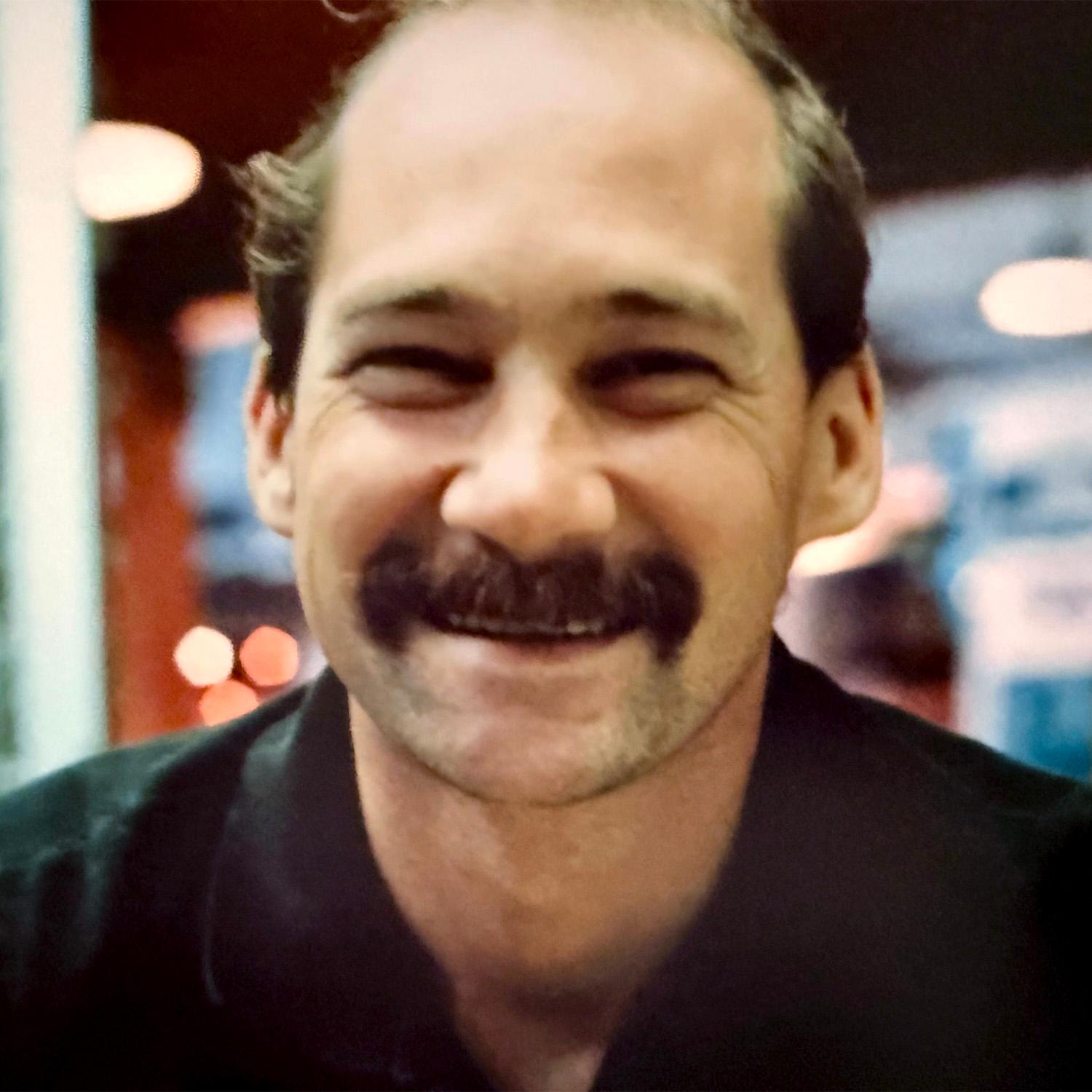
Rick “BD” Reifer was Samantha Reifer’s father, a dad of three girls.
“He grew up mostly in Istanbul until he was 16, and then moved out to the United States on his own, in Pennsylvania and making his way out to California,” she said. “He spent essentially the rest of his life building friendships, building his family, and making lifelong friendships.”
“He loved work, he loved taking walks, he loved gardening. He loved being such a prankster and jokester,” she said. “He never really fully bought into growing up.”
“He was always our No. 1 supporter. No matter what we did,” she said. “I just don't even know how that was sustainable with three girls — and I wanted to do everything. He would drive me from volleyball practice to soccer to dance, and the same night. And I just wish there was just so much more I could give and do for him.”
“He was 69 years old. We had just celebrated his birthday on June 25th, and then we lost him on July 22, a few weeks later. So it was hard.”
“I just want to celebrate him as much as possible,” she said. “Maybe the ending isn't always the most important part of people's stories.”
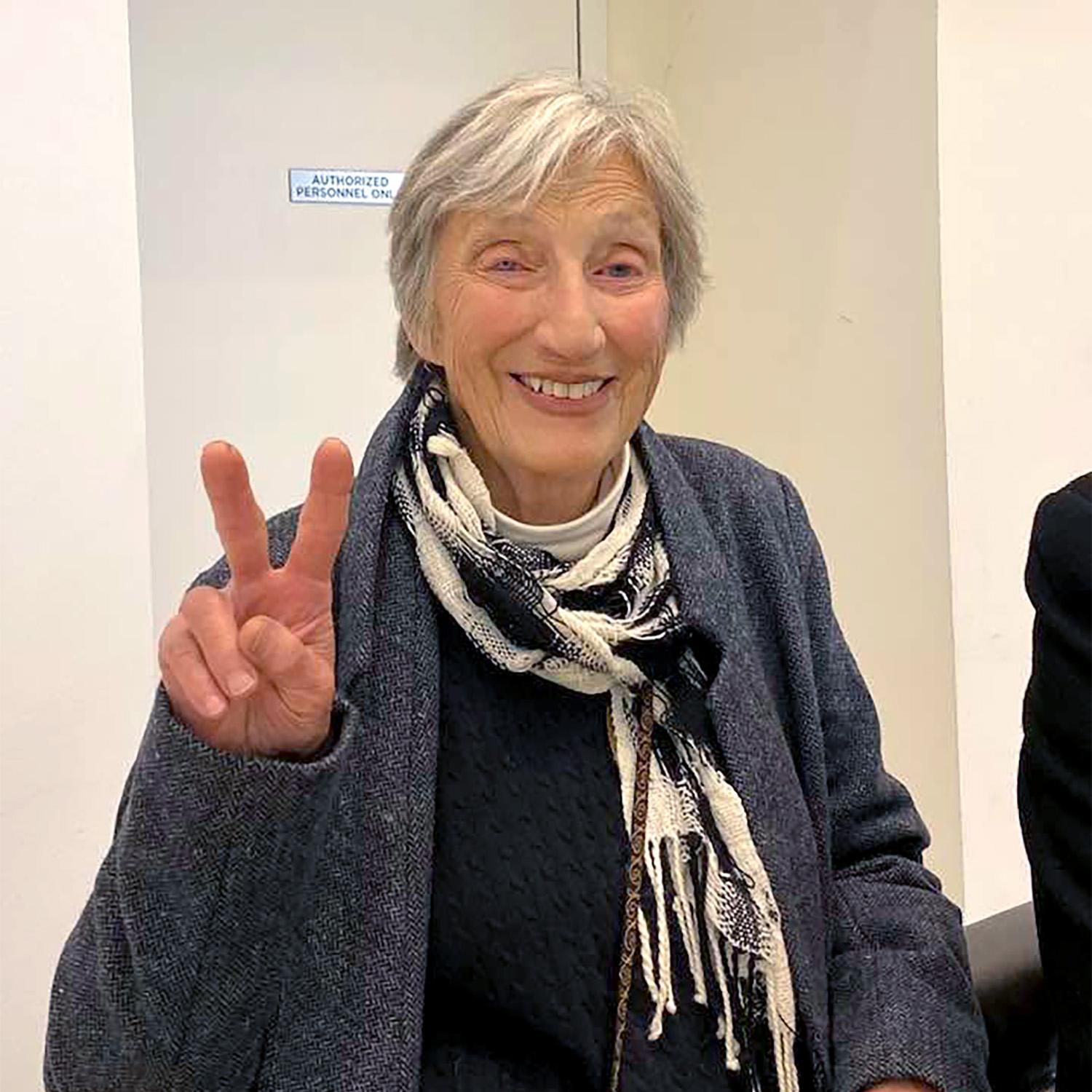
Bette Rittinger was Scott Rittinger’s mother.
“She always wanted to have animals and horses in particular,” he said. “When they could, my parents bought a farm, a very old Pennsylvania Dutch farm in the Amish country of the Lehigh Valley. And that's where my sister and I grew up. And my mom was just an amazing person. She made everything, she made hand-braided rugs and giant Easter baskets and all our Christmas tree decorations.”
She got into alpacas — the llama-like animal — when she moved to Colorado, even importing textiles from Peru to sell in Nederland. Rittinger said she was influential enough to get an alpaca figure installed in the town’s famous Carousel of Happiness.
“My mom just always had this caring nature for animals and other people that just sort of spread to, and affected everyone,” he said. “I really appreciate what my mom fomented in my mind, about empathy and curiosity and desire to understand the backgrounds and situations of other people and cultures.”
“What I got from my mom is the ability to be resourceful and industrious and just figure out how to make things work with what you have.”
“She just was a ranch woman at heart and in practicality, and did not want to leave the ranch. She always said she wanted to go toes up there.”
“She was an amazing force of nature, but never had a plan, no organization, no nothing,” he said. “She followed a path that created itself.”
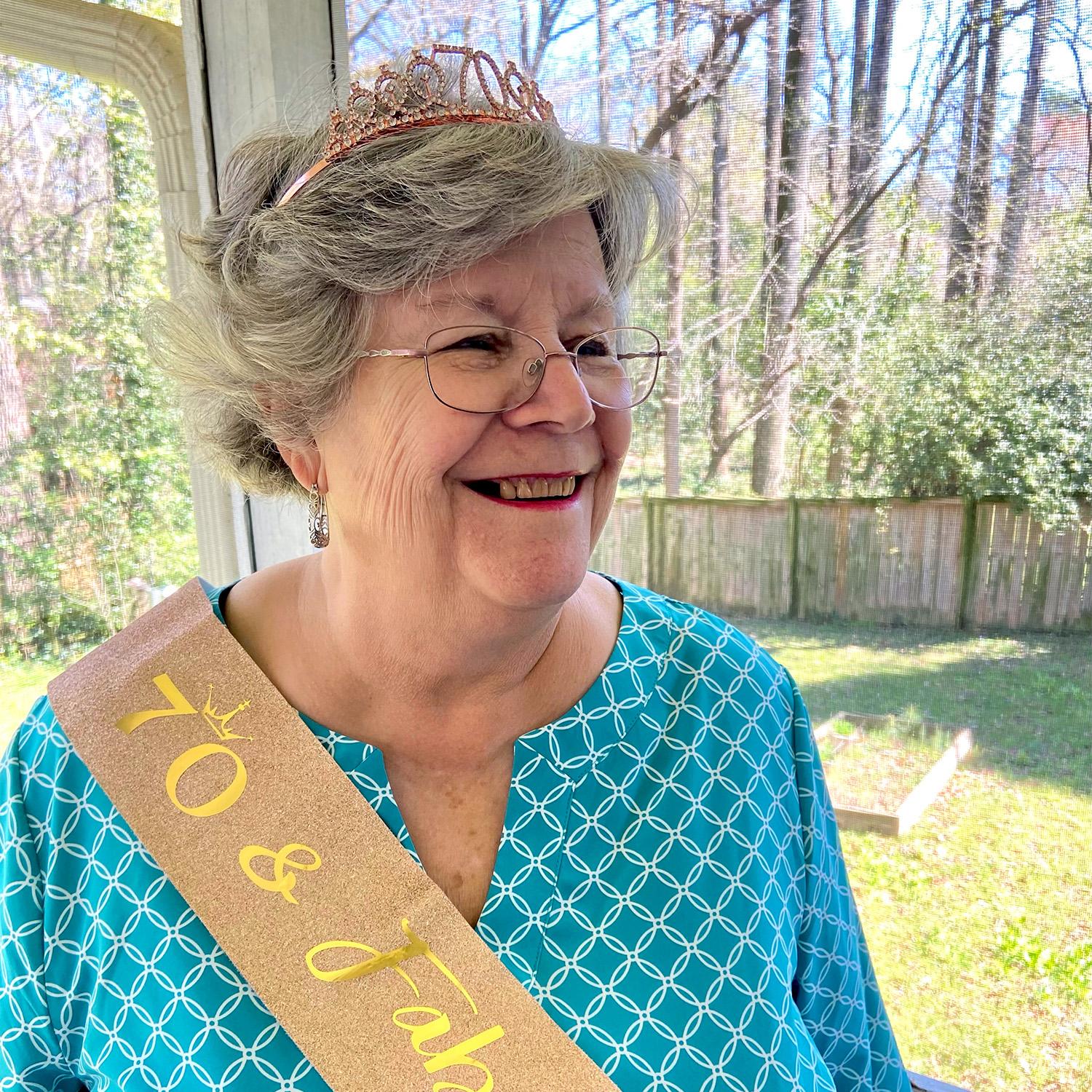
Melinda Conger was Geoff Taylor’s mother. She raised her kids in a small Georgia town.
“She was a single mom for a while and raised me and my brother. She always tried to provide for us and just make sure we had everything we needed. And she was a teacher for almost 30 years. So to a lot of the people in the community, she had been their teacher at some point,” he said. “People knew her as their teacher or they knew her as Geoff’s mom.”
“I'll always remember her generosity. I mean, being a teacher in an underfunded public school system, a lot of her own money went into making sure her students had what they needed. She also liked to volunteer at the food bank at her church. So I always remember their acts of generosity.”
“I also remember she had a sense of humor that I could be very kind of sassy,” he said. “To an outsider who didn't know her, they would think, ‘Wow, she really doesn't like that person.’ But in reality, she loved that person. It’s just the way her sense of humor came across.”
“She loved going to the beach, even from when she was a little girl,” he said. “She also loved animals.”

Joel Snow was Ari Snow’s father, whom his son described as “husband, father, physicist, earth lover, psychonaut, viper.”
“He was born in Providence, Rhode Island in 1951. He was my father. He was a high-energy physicist who graduated from Yale University. Grew up as a Baby Boomer, anti-war, lifelong vegetarian from 21 until he passed away at 72. He enjoyed running, blues music, consciousness expansion. He loved his family.”
“His father fought in World War II. I think that left an interesting flavor for that generation, to not really want to conform as much. And they didn't want to see war ever again. But physics, I think that and consciousness expansion were kind of related. He saw a bigger universe than people.”
“He loved blues music. He had the blues. He told me that as I became older, that there was something inside him that he couldn't really explain, feelings of sadness, of darkness. So he would listen to this music, and you would just see him become so animated — as he put it, he loved to boogie.
His father “empathized with the working class” and was invested in politics. News broadcasts make the son think of his dad, more so lately.
Casting his portrait onto the clock tower, a giant, glowing ofrenda, would provide a better way to mark his passing.
“Hopefully, seeing him memorialized further in some way will give myself and my family a little more closure,” he said. “It's just important to remember both the good and the bad of people that have passed. Try to focus on what made you love them.”
